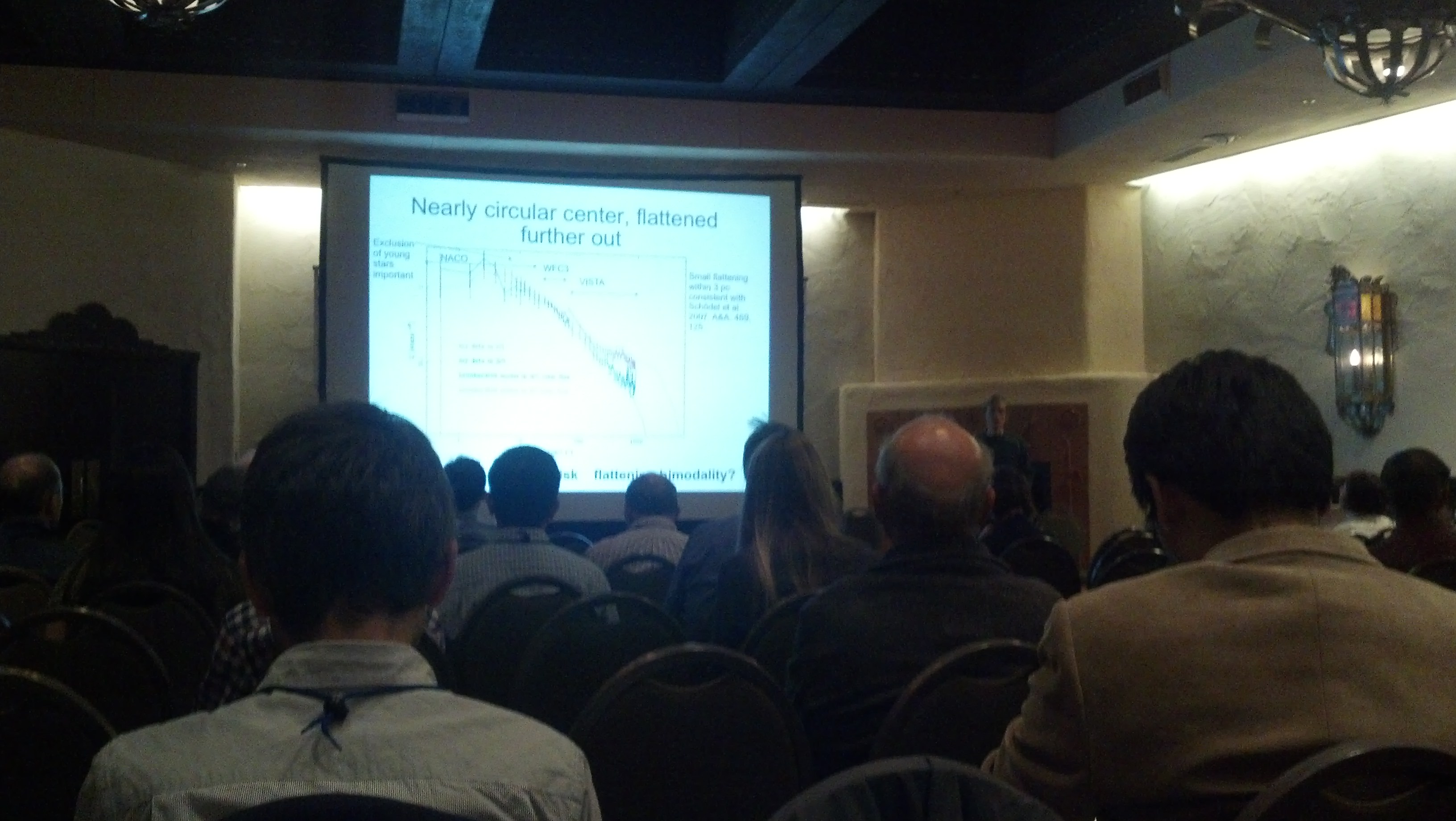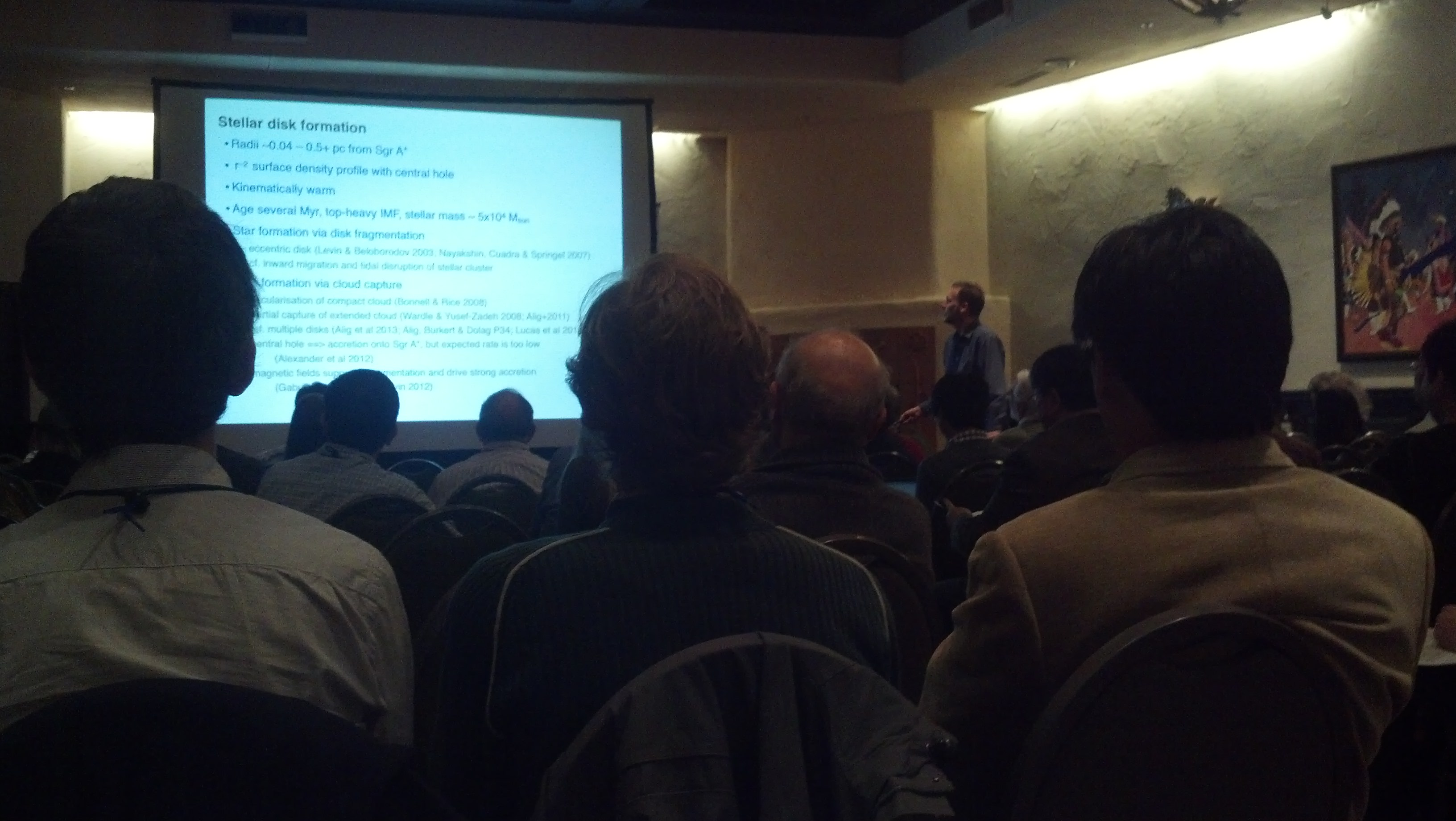4:15-4:35 pm Tobias Fritz (Germany): Nuclear Cluster of the Milky Way (15 + 5 minutes)

- Model fitting of nuclear cluster: Sersic, etc.
- unusually bright nuclear cluster for its size
Globular cluster origin of nuclear cluster
Questions:
- Q: Round component consistent with inspiraling globular cluster. What about spectral properties?
- A: No. Metallicity difficult.
4:35-4:55 pm Tuan Do (Canada): Measuring the physical properties of the Milky Way Nuclear Star Cluster with 3D stellar kinematics (15 + 5 minutes)

- Dynamics of CMZ stars
- Massive black hole affects dynamics of a cluster
- testing presence of cusps + old stars have no cusp + young stars have a cusp, but not dynamically relaxed
- what is the true stellar density profile? + can't determine by counting + kinematics can help + old stars randomly distributed + young stars concentrated
- did the stats right + no binning + individual likelihoods + unfortunately, this is new
- flat slope, no anisotropy
- correlation between parameters, particularly the slope and BH mass
- edge of core poorly constrained
- infalling IMBH or SMBH destroys stellar cusp + observational constraints on IMBHs poor
- QUESTION: Do the fits improve at all if you impose a GC distance? + Answered: Can merge with PDF from stellar orbits
Question
- Q: Inconsistent with 7.7 kpc distance to CMZ?
- A: no, consistent within 1-sigma
- Q: How do you contrain R_0 with this approach?
- A: radial velocities give absolute scale. Proper motions must also have some scale. Match the scales to get R_0
- Q: Don't use any information outside 0.5 parsecs. Shouldn't you include it? I get the right mass if I do
- A: Will help, but velocity dispersion dominated by nearest stars
- Q: Anisotropy in cluster. Get rid of red supergiants somehow? Tangential or radial?
- A: Hard to know. Very little anisotropy.
4:55-5:15 pm Mark Wardle (Australia): Star Formation within 0.5 pc of SgrA* (15 + 5 minutes)

"Highest I've ever been for a talk"
- High densities needed to overcome tidal shear
- big cloud -> Hoyle-Littleton accretion + self-intersecting orbit on the backside of the cloud
- central hole because accreted?
- high magnetic pressure in disk: 10x greater than gas
- B-fields suppress fragmentation
- Black hole takes bite out of cloud
- optically thick disk: sigma T_eff^4 cooling + heating due to starlight, accretion
- twisting knobs to figure out where accretion disk turns into fragmenting disk + inside, magnetically active / supported + outside (0.04 pc) fragmenting + further out: grav stable
- maybe high accretion rate drove fermi bubble
- accretion rate consistent with 10^6 Msun/Gyr -> build Sgr A*
Questions
- Q Mitch: Grav unstable region globally unstable?
- A: Has to do with the disk height. h/r very small, not an issue
- Q Fred Lo: We don't see any of this observationally. All history?
- A: Yes, this all happened a few Myr ago.
- Q: Eddington accretion: what happens to rest of star formation and the disk?
- A: I think it's OK - star formation 10^4-10^5 years, but dump time 10^5-10^6 yrs
- Q: Bonnel & Rice did simulations. Why need more?
- A: B-fields? Eqn of state? Radiative cooling? Crazy enough initial conditions?
- A Farhad: didn't include radial distribution of stars
- Q: How do you start with 0-angular-momentum cloud?
- A: Lots of junk around, maybe collisions do it. I don't have a good answer. Depends on how big a fluffy cloud you use.
- Q Fred Lo: What observational signature remains?
- A: Maybe kinematics
5:15-5:35 pm Andrea Ghez (USA): Probing General Relativity with Short Period Stars at the Galactic Center (15 + 5 minutes)
- Why continue studies of GC stars?
Test GR
Role of BH in galaxies
Depth of potential 100x greater, on mass scale 10^6 larger than other tests
simplest tests + Relativistic redshift (easy) + Precession of periapse
SO-2 "star of the show" + next close approach in 2018.5 + relativistic signal ~200 km/s + need very accurate keplerian orbit first + radial velocity from BrG
absolute reference frame is tough + masers give the reference frame, but require larger field
full orbital coverage with astrometry + 13-parameter model
Systematic drift in reference frame + There is a major source of systematic error + Spatial variation in PSF (AO issue) is the worst systematic + drift term prevents bias + 5 km/s uncertainty projected by 2018
- 5-sigma GR detection
GEMS to make reference frame
TMT could do 2-yr orbits
Questions
- Q Ostriker: Could the SMBH be sloshing? Can you allow for that? What about acceleration?
- A: Mark Reid did calculation. Limit ~3 km/s for present BH velocity. Problem: assume linear velocities, but that is not always a safe assumption. If BH accelerating, would create "nonphysical" accelerations.
- Q: Many things spiral into center, will lead to oscillations in BH motion
- Q Stocke: How big an effect is blending with unseen stars?
- A: We simulate it. But, trying to simulate something we don't understand. <0.1 mas
- Q: Contributions from resonant relaxation, encounters with other stars.
- A: Skipped the slide that shows this. For GR, insignificant, but for precession of periapse, have to worry.
- Q: What about the velocity component?
- A: small effect on velocity.
Discussion Section
- Q: IMFs shallower than salpeter.
- A Lu: Hard to decouple from dynamical history. push on spectroscopy to lower masses. Decouple young and old populations
- A Fritz: instrument sensitivity limit... VLT can detect CO bandheads...?
- How well do we know it's 2 populations, or maybe it's just 1 population? Assumptions disagree, not measurements
- Stocke: Background is changing in center. Can you use fluctuation analysis to determine brightness of lower mass stars?
- Lu: Very challenging for young stars because they're a small fraction of the total luminosity. Foal(?) et al did good work on older star populations
- Arches cluster: Hui Dong found 4 runaways of same mass as the 12 stars in the Arches cluster. Maybe as many runaways as cluster stars? Half of cluster stars kicked out. Do dynamical models predict this?
- [silence]
- Find massive stars in "other 3/4" (I'm lost...). Need spectroscopy
- Ghez: Role of binary stars in ejections.
- Missing half of cluster mass?
- Ghez: Role of interaction with black hole? Clusters not evolving in isolation
- Arches 2.5 Myr old. Largest stars could just start... evolving?
- Most difficult objects to explain are LBVs. LBVs outside of cores of clusters. How do you get very massive binaries out of cores? All LBVs found are outside cores.
- Role of binaries. New evolutionary models. LBVs that must be <2 Myr, WCs must be >4 Myr. Contradiction?
- New evolutionary models say many stars come from rejuvenation. Massive blue stragglers.
- In situ formation? What fraction should be expected to be formed in situ?
- How confident are we about mass-luminosity relation for stars?
- Lu: On main sequence, confident, but post-main-sequence is uncertain. We drop them in our analysis. Pre-main sequence is a problem in Arches. Arches fitted with only main-sequence stars
- very difficult with rotation included
- Distance to the Galactic center "decreasing at an alarming rate". Does determination conflict with any other indicators? What does that mean?
- Ghez: Mark Reid likes lower R_0. All consistent within uncertainties
- Do simulations for S stars include interactions between stars?
- Ghez: Not in most recent version, but in an earlier version
- How does this test of GR compare with other tests of GR around Sgr A*?
- Ghez: Event Horizon Telescope, GRAVITY.
- Different systematics.
- Are HST data consistent with BH at center?
- Tuan Do: Same reference frame. BH defined to be at center. Velocity can drift, but not position